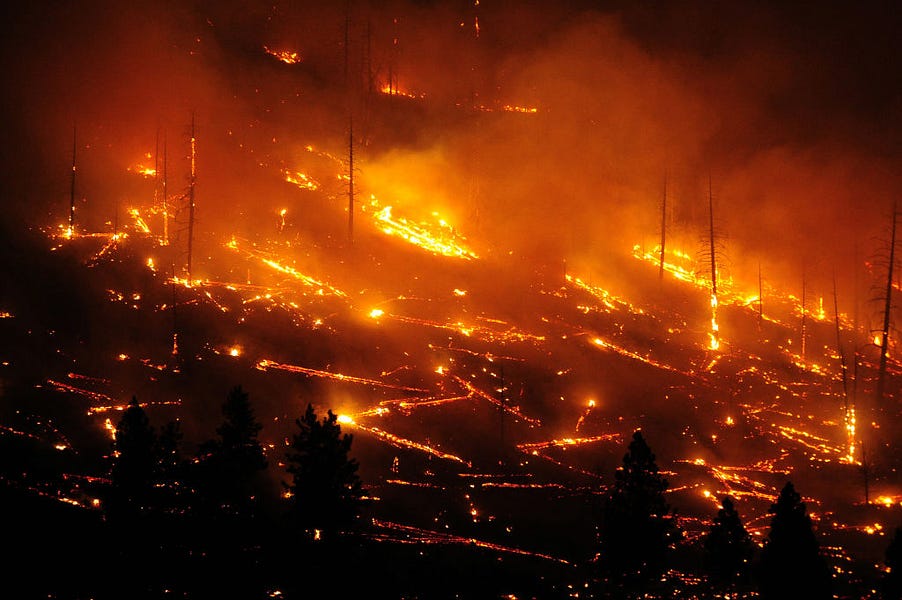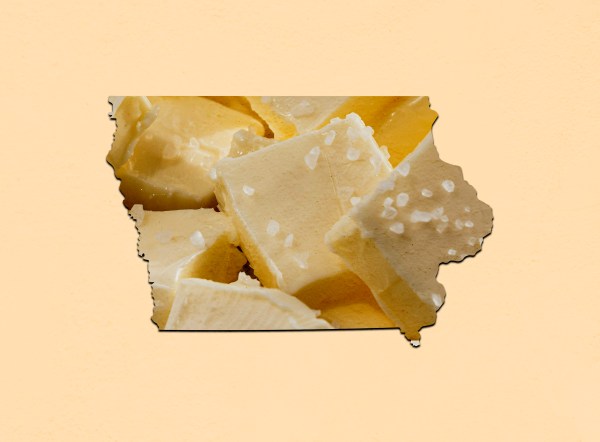Last August and September, Americans were treated to images that seemed straight out of a science fiction movie (or the Book of Revelation), as massive wildfires turned skies an unsettling orange across many parts of California and Oregon. It was one of the most destructive wildfire seasons ever for the West, destroying $16.5 billion in property (including about 10,000 buildings), and costing more than $3 billion to suppress.
As bad as that was, this fire season has the potential to outpace it. Twin accelerants—extreme heat and a lack of water—threaten to make the western United States a veritable tinderbox.
The region has had a hot start to the summer, to say the least. Residents of the Pacific Northwest have dealt with record-setting temperatures: Portland saw its three hottest days ever from June 26–28. Temperatures climbed above 100 degrees Fahrenheit in a city that typically sees highs in the upper 70s in June. It was the result of a “heat dome,” a high-pressure system inhibiting the rise of hot air, pushing it down and making the atmosphere denser and hotter. The dome in the Northwest comes after a succession of other heat waves throughout the American West in early and late June, stretching from Wyoming to California.
If temperatures hot enough to shut down public transit and buckle freeways weren’t enough, the West is also facing a historic drought, the worst and most widespread in decades. Utilities in some Northern California communities have already imposed water-use cuts of 30 to 40 percent for commercial and residential consumers. Farmers are forced to choose which crops they wish to irrigate and which to allow to lie fallow. These hard choices aren’t unusual—especially in drought-prone California—but this extreme summer is making them especially difficult.
The heat wave and the drought, big enough problems in themselves, also threaten to amplify the risk of massive wildfires. In an interview with The Dispatch, Jon Keeley, a research scientist with the U.S. Geological Survey who studies fire ecology, said that “fire season” is not a set of fixed dates, but that it “changes year to year … this year it started much, much earlier because the rain stopped.”
Keeley added that “two things make fires bad, the volume [of fuel] and the moisture [levels of the fuel].”
In terms of volume of fuel, past droughts are a huge factor. “In California, you can’t rule out the incredible impact of the drought we had from 2012 up through 2017 in some parts of the state” in creating dead vegetation that helped power the 2020 fires—and continues to exist in many areas that did not burn in 2020, Keeley said. Dieback from drought (when trees and other plants begin to slowly die) “leaves a legacy on the landscape,” he noted, an effect that can persist beyond a specific period of drought.
Additionally, longstanding forest management policies of fire exclusion— putting out forest fires as quickly as possible, especially when close to human settlement—have allowed many forests to grow denser, supplying more dry, woody fuel for fires to feed on. Suppressing smaller blazes sometimes lays the groundwork for massive ones later on.
So what, if anything, have communities done to prepare? In California, the site of last year’s most destructive fires, Gov. Gavin Newsom has called for $2 billion for fire preparedness in this year’s budget. The proposal calls for greater investment in building firebreaks, thinning overgrown forest land, and removing dead vegetation, as well as expanding the state’s fleet of firefighting planes and trucks.
In Oregon, where fires last Labor Day forced 40,000 people to evacuate, the legislature has passed Senate Bill 762, which provided additional funding for firefighting, mandated that utilities create wildfire mitigation plans, and adopted wildfire-resistant land-use and building code regulations with buffer zones around homes in high-risk areas and fire-resistant construction materials.
While much media coverage emphasizes the impact of climate change, it’s a welcome sign that policymakers are focusing on small-bore technical fixes for the many other causes of wildfires.
“People always aim at climate change right away … [but] we were in trouble a long time ago,” said Craig Thomas, the founder of the Fire Restoration Group, which works with governments and communities to integrate fire ecology with fire management. Both he and Keely noted that while climate change certainly exacerbates the problems by increasing drought and heat waves, other problems, ranging from an overemphasis on fire exclusion, to the expansion of human settlement into fire-prone areas, to an increase in ignitions started by humans, are all also major contributors to the uptick in the frequency of massive blazes.
Thomas also commended legislators’ recent emphasis on better forest management, highlighting the recent introduction of the National Prescribed Fire Act by four Democratic senators (Rep. Bruce Westerman, the only registered forester in Congress, has also spoken to The Dispatch about the need for better forest management). However, Thomas emphasized the need for a permanent workforce to manage controlled burns, rather than using firefighters in the limited time available between fire seasons.
The problem will not be fixed this year, or in the next few. Too much forest has been left unmanaged for decades. In the West, and especially drier states like California, fire is simply part of the landscape. “Fire and rain define what California is,” Thomas said. Communities can hope to reduce the frequency and destructiveness of fire only with better management and effective mitigation, in steps as simple as clearing fire-defensible spaces around their homes or making sure their roofs are fire-resistant, Thomas stressed.
But the focus will soon shift from planning for the future to putting out the fires springing up now. Last week, 17 wildfires started in California, with the Lava Fire in Siskiyou County forcing the displacement of 3,500 people. And that was before the Fourth of July holiday and its attendant fireworks celebrations. Last year’s destructive El Dorado fire was caused by a pyrotechnic device at a gender-reveal party. Jon Keeley noted that however extensive 2020’s fires were, “There’s a hell of a lot of landscape left to burn.”







Please note that we at The Dispatch hold ourselves, our work, and our commenters to a higher standard than other places on the internet. We welcome comments that foster genuine debate or discussion—including comments critical of us or our work—but responses that include ad hominem attacks on fellow Dispatch members or are intended to stoke fear and anger may be moderated.
With your membership, you only have the ability to comment on The Morning Dispatch articles. Consider upgrading to join the conversation everywhere.